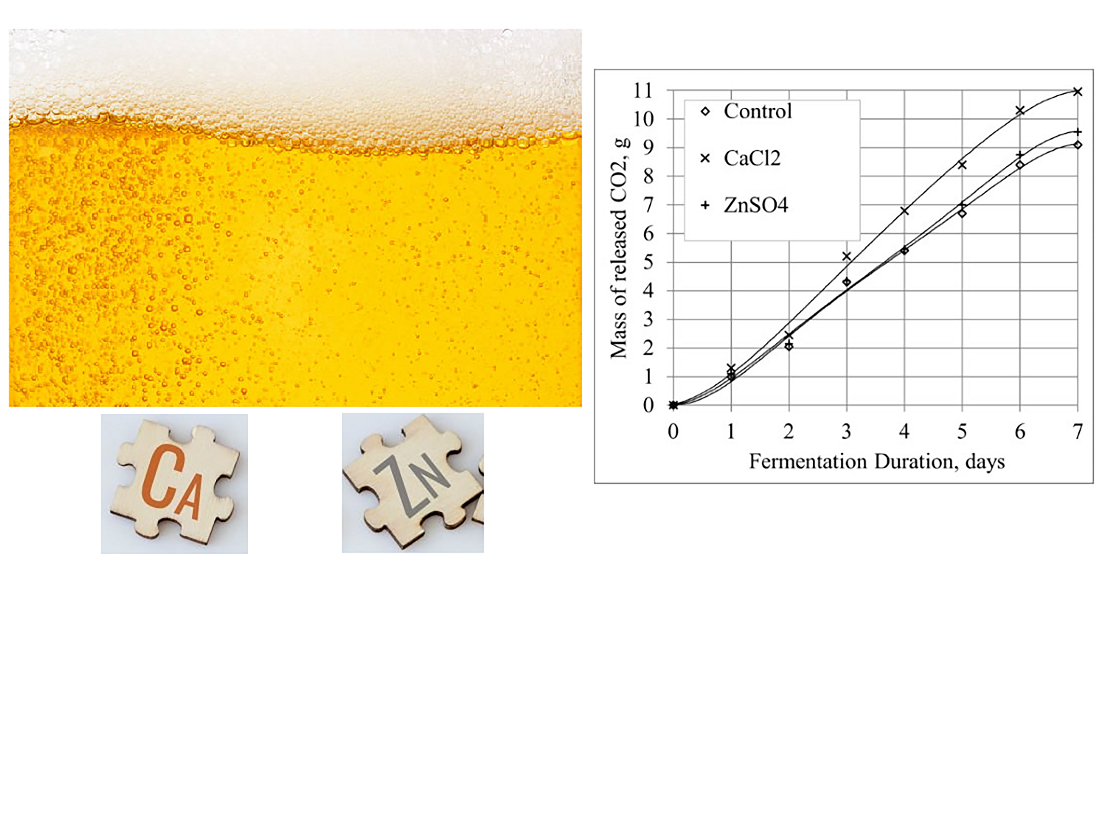Intensification of high-gravity brewer’s wort fermentation process with the use of microelements
DOI:
https://doi.org/10.15587/1729-4061.2024.305548Keywords:
high-gravity brewing, fermentation, yeast, microelement ions, calcium, zincAbstract
In high-gravity brewing, conditions arise that adversely affect the yeast. These are high osmotic pressure, high fermentation temperature, high ethanol content. As a result of these unfavorable factors, the intensity of yeast reproduction and the rate of fermentation decrease, the duration of the process increases, the degree of fermentation decreases, which leads to a change in the taste and aroma profile of the drink. Cofactors of important enzymes and stress modulators are microelement ions, the optimal content of which can be provided by adding appropriate salts to the wort.
In this work, the influence of calcium and zinc on the fermentation of high-gravity beer wort with the participation of Saccharomyces cerevisiae yeast strain Saflager W-34/70 was investigated.
The optimal dosage of CaCl2 and ZnSO4 salts was determined, which is 5.0 and 0.1 mg/dm3, respectively. It was established that adding CaCl2 to the wort leads to an increase in the rate of fermentation by 21.9 %, the apparent and actual degree of fermentation by 17.8 and 17.0 %, respectively. At the same time, the ethanol content in young beer increases by 19.1 %, the content of visible and actual extract decreases by 28.8 and 17.5 %, respectively, and the biomass of yeast accumulated during fermentation increases by 14.0 %. When using ZnSO4, the changes in the values of all these indicators are significantly smaller and lie in the range of 3.2‒5.8 %. Other physical-chemical parameters of the studied samples of young beer, namely acidity, pH value, content of vicinal diketones, do not undergo significant changes.
To enhance the growth and metabolism of yeast under adverse conditions that occur during high-gravity brewing, it is recommended to add CaCl2 to beer wort in the amount of 5.0 mg/dm3. This will make it possible to reduce the duration of fermentation of wort with a dry matter content of 18 % at a temperature of 15 ℃ by 1.5 days (21 %)
References
- Kosiv, R. (2021). Comparing the efficiency of applying yeast of different generations in high gravity brewing. Eastern-European Journal of Enterprise Technologies, 6 (11 (114)), 52–59. https://doi.org/10.15587/1729-4061.2021.248126
- Kosiv, R., Kharandiuk, T., Polyuzhyn, L., Palianytsia, L., Berezovska, N. (2016). Optimization of Main Fermentation of High-Gravity Wort. Chemistry & Chemical Technology, 10 (3), 349–353. https://doi.org/10.23939/chcht10.03.349
- Kosiv, R., Kharandiuk, T., Polyuzhyn, L., Palianytsia, L., Berezovska, N. (2017). Effect of high gravity wort fermentation parameters on beer flavor profile. Chemistry & Chemical Technology, 11 (3), 308–313. https://doi.org/10.23939/chcht11.03.308
- Nicola, R. D., Walker, G. (2009). Interaction Between Yeasts and Zinc. Yeast Biotechnology: Diversity and Applications, 237–257. https://doi.org/10.1007/978-1-4020-8292-4_12
- Nobis, A., Berg, B., Gastl, M., Becker, T. (2022). Changes in bioavailability of zinc during malting process and wort production. European Food Research and Technology, 249 (1), 157–165. https://doi.org/10.1007/s00217-022-04141-5
- Jacobsen, T., Gunderson, R. W. (1983). Trace element distribution in yeast and wort samples: An application of the FCV clustering algorithms. International Journal of Man-Machine Studies, 19 (1), 105–116. https://doi.org/10.1016/s0020-7373(83)80045-5
- Naik, R. P., Preetam, V. C., Kumari, N. N., Raju, M. V. L. N., Prakash, B., Reddy, M. R. (2021). Effect of Different Zinc Sources and Concentrations on the Biomass Yield of Saccharomyces cerevisiae Yeast. Biological Trace Element Research, 200 (9), 4171–4174. https://doi.org/10.1007/s12011-021-02998-3
- Koshova, V., Yazhlo, V., Kaplunenko, V., Ogorodnyk, Y. (2015). Increase of fermentative activity of brewing yeast using zinc nanoaquachelate. Eastern-European Journal of Enterprise Technologies, 4 (10 (76)), 40–44. https://doi.org/10.15587/1729-4061.2015.47888
- Xie, D., Sun, Y., Li, X., Ren, S. (2023). Effect of calcium levels on structure and function of mitochondria in yeast under high glucose fermentation. Food Science and Technology International, 108201322311704. https://doi.org/10.1177/10820132231170409
- Walker, G., Nicola, R., Anthony, S., Learmonth, R. (2006). Yeast-metal interactions: impact on brewing and distilling fermentations. Proceedings of the Institute of Brewing & Distilling Asia Pacific Section 2006 Convention. Available at: https://research.usq.edu.au/item/9xvxx/yeast-metal-interactions-impact-on-brewing-and-distilling-fermentations
- Poreda, A., Tuszyński, T. (2007). Influence of magnesium and zinc ions on trehalose synthesis and fermentation activity in brewing yeast Saccharomyces cerevisiae. Ecological Chemistry and Engineering S, 14 (2), 197–207. Available at: https://www.researchgate.net/publication/241699406_Influence_of_magnesium_and_zinc_ions_on_trehalose_synthesis_and_fermentation_activity_in_brewing_yeast_Saccharomyces_cerevisiae

Downloads
Published
How to Cite
Issue
Section
License
Copyright (c) 2024 Ruslana Kosiv

This work is licensed under a Creative Commons Attribution 4.0 International License.
The consolidation and conditions for the transfer of copyright (identification of authorship) is carried out in the License Agreement. In particular, the authors reserve the right to the authorship of their manuscript and transfer the first publication of this work to the journal under the terms of the Creative Commons CC BY license. At the same time, they have the right to conclude on their own additional agreements concerning the non-exclusive distribution of the work in the form in which it was published by this journal, but provided that the link to the first publication of the article in this journal is preserved.
A license agreement is a document in which the author warrants that he/she owns all copyright for the work (manuscript, article, etc.).
The authors, signing the License Agreement with TECHNOLOGY CENTER PC, have all rights to the further use of their work, provided that they link to our edition in which the work was published.
According to the terms of the License Agreement, the Publisher TECHNOLOGY CENTER PC does not take away your copyrights and receives permission from the authors to use and dissemination of the publication through the world's scientific resources (own electronic resources, scientometric databases, repositories, libraries, etc.).
In the absence of a signed License Agreement or in the absence of this agreement of identifiers allowing to identify the identity of the author, the editors have no right to work with the manuscript.
It is important to remember that there is another type of agreement between authors and publishers – when copyright is transferred from the authors to the publisher. In this case, the authors lose ownership of their work and may not use it in any way.









